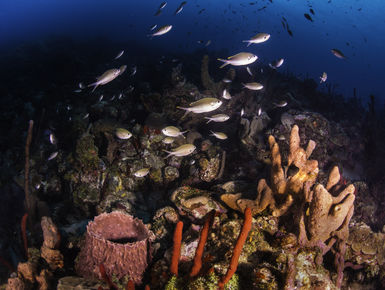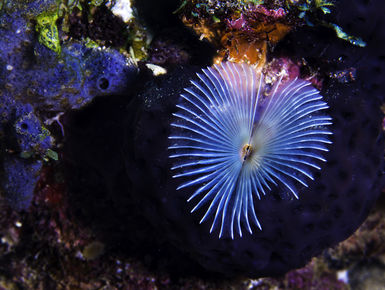
Bright reefs, Small creatures and Big adventures
St. Vincent has been called the “critter capital of the Caribbean.” Muck diving enthusiasts certainly find much to like, but this isn't the whole story. Not far from sites that hide frogfish are multi-hued reefs likened to a Japanese garden. Other sites offer maze-like boulder fields, vertical walls and swim-through caverns. A trio of historic wrecks await exploration, and for the truly adventurous, there are caves and high-speed drift dives. Stretching southward from St. Vincent is the Grenadines, a chain of small islands and remote cays with an equally delightful and diverse collection of dive sites, along with idyllic beaches and postcard-perfect harbor towns.
Highlights
- Best for: All Divers
- Best season to visit: Year round
- Weather: Water and wind serve to moderate season temperature differences, with nights dropping into the low to mid 70s, and daytime highs ranging from the low 80s in January to the high 80s in August. The dry season runs from January to April
Things to Do
- • Sailing
- • Surfing
- • Windsurfing
- • Kitesurfing
- • History tours
- • Nature hikes
St. Vincent & The Grenadines Information
About Diving in St. Vincent & The Grenadines
Dive sites on the island of St. Vincent lies primarily along a 15-mile stretch of coastline from the island's southern tip to the central west. This area encompasses a diver’s range of underwater landscapes from shallow sandy bays to finger reefs, boulder fields, slopes and walls. Many sites include overhangs, crevices and canyons that become hiding places for marine life, while exposed walls and outer reefs attract larger fish, including tarpon, rays, turtles and the occasional black tip or reef shark. To the south, the islands of the Grenadines add more than 100 additional dive sites to a mix that includes wrecks, shallow and deep reefs and offshore rock pinnacles. Water temperatures stay within a narrow range from 79 to 82 degrees.
Diving in St. Vincent & The Grenadines Tips
Even with some creative island hopping, there's no way to take in all the diving opportunities this island group has to offer in a week. Instead, pick an island and resort and max out the local opportunities, because there's excellent and varied diving all along the archipelago. And you can always come back.
Best Places to Dive in St. Vincent & The Grenadines
When the currents are running, the Oblizalo Drift delivers an exhilarating ride through canyons and boulder fields. More sedate but equally memorable are the brilliant colors at Japanese Gardens. At the Mabouya Whirlpool, bubbles of geothermal gas spiral towards the surface. Seahorses and frogfish hide among the boulders of Turtle Bay, while strange creatures lurk in the sands of Over There. The Kingston wrecks are a literal pile-up of ships, and the Bat Cave is not as scary as it sounds. After exploring the Moonhole Wreck, drift over to the adjacent reef to watch cleaner shrimp at work.
What to Pack for Diving in St. Vincent & The Grenadines
A 3mm wetsuit. Surface marker and deployment reel for drift dives. A dive light for wrecks, crevices and night dives, a muck stick for stability when observing small marine life, and a fish I.D. slate.
Diving in St. Vincent & The Grenadines
St Vincent offers a wide range of underwater landscapes that create an equally diverse menu of diving experiences. The majority of dive sites are located along the island's southwestern coast, where they are sheltered from easterly trade winds and Atlantic swells. The northwestern coast offers equally interesting sites but is less visited due to longer run times from dive resorts located near Kingston. There are dive profiles suitable for all experience levels. Currents are not a constant, and range from nonexistent to strong, depending on both location and timing. Anyone comfortable with drift diving will find a number of exciting possibilities, including the southern site of Rock Fort, where often strong currents wash over a landscape of boulders, caves and coral-covered slopes where sea fans and sponges bend to the forces of flowing water. Another high-voltage dive is the Oblizalo Drift, which propels divers over steep drops and through canyons and into a secluded bay for a relaxing off-gassing among the corals. A distinctive feature of St. Vincent's underwater landscape is the profusion of multi-colored sponges and soft corals. Walls, slopes and reef are thick with barrel, rope, encrusting, stovepipe, vase and orange elephant ear sponges, along with gorgonians, sea whips and rods, and antipatharia corals in shades from pink, red and orange to jet black. One shallow wreck divers can explore the Romark, a 160-foot, purpose-sunk cargo vessel that rises from depths of 130 feet to within 45 feet of the surface. A more unusual site is known as the Kingston wrecks. Here, the remains of an 18th century French frigate sit under the hulls of a freighter and tugboat that collided and came to rest in an underwater pileup. Slow and steady is the way to approach the volcanic sand bottoms at Critter Corner or Over There, where keen observations will uncover cryptic and unusual finds such as electric rays, seahorses, flying gurnards, frogfish, yellowhead jawfish, snake eels, fan worms and the rare red-banded lobster. Another unique shallow water hunt takes places at Bottle Reef, which is named for the discarded rum and gin bottles that soldiers once tossed from the overhanging cliff at Fort Charlotte. St Vincent also has its novelty dives, including a geothermal reef and a semi-flooded chamber known as the bat cave, which is inhabited by its namesake flying mammals, and opens into an underwater fissure at a depth of 45 feet. The islands of the Grenadines provide an additional wealth of diving adventures. The largest, Bequia, is known for drift dives, and nutrient-rich waters flowing through Bequia Channel attract schooling jacks, sharks and rays. Also on the roster are the Stratmann and Rick's H wrecks, which lie in approachable mid-range depths. Relaxing encounters await at the cleaning stations of Moonhole Reef, and at Browns Bay, where reefs covered in sea fans and staghorn coral provide hours of critter hunting at depths from 15 to 45 feet. Canouan Island is flanked by a long barrier reef that provides calm explorations on one side, and lively drifts on the other. Also noteworthy are the lava flows that resemble giant stair steps covered in soft corals. This island and nearby Palm Island are also gateways to Mayreau Island in the Tobago Cayes Marine Park, where a two-mile expanse of Horseshoe Reef encloses a 1,400-acre lagoon that becomes a nursery for tropical fish and turtles.
Passport and/or Visa Requirements
Entry/Exit Requirements: All U.S. citizens are required to present a valid passport with at least 1 blank page for entry stamp. No visa is required. A departure tax of EC $30.00 is levied on all passengers leaving St. Vincent.
Immunizations
Vaccinations are not required for entry into St. Vincent. Check with your doctor and the Centers for Disease Control on recommended vaccinations for travel at cdc.gov.
Culture and Customs
There's a cinematic quality to St. Vincent's landscape. Waterfalls plunge from green volcanic peaks; palms sway on black sand beaches and cannons ensconced in a stone fortress overlook a port city where Colonia-era buildings face cobblestone streets. Ditto for the postcard-perfect islands of the Grenadines, where sailboats bob at anchor in turquoise lagoons, and shore-side rum shops welcome an eclectic mix of local characters, vagabond mariners and celebrities lying low. These scenic treasures were not lost on the movie crews who transformed St. Vincent's Wallilabou Bay into historic Port Royal for the Pirates of the Caribbean movies. But reality can be even more rewarding. Adjacent to one of the best-preserved forts in the Caribbean is a 250-year-old botanical garden filled with exotic plants gathered from far corners of the world by the likes of Captain Bligh. The island's wilder nature still holds sway in the verdant interior, where hikers can wander miles of rainforest trails in the Buccament Bay valley, or set their sights on the 4,000-foot summit of La Soufriere Volcano. The island's history unfolds at the National Museum, and visible reminders of the original inhabitants can be seen in the rock carvings at Mesopotamia. Die-hard adventurers can follow a rugged cliff-side path to the emerald pool at the Falls of Baleine, but it's far easier to arrive by boat. Maritime traditions remain strong on the island of Bequia, where artisanal boat builders still craft sloops and fishing boats from native woods. Mustique is a haven for the famous seeking respite from the public eye, and Canouan and Mayreau are reputed to have some of prettiest beaches in the world.
Electricity, Phone and Internet Access
Electricity in St. Vincent is 220/240 volts, 50 cycles,and use a U.K. style 3 pin plug, so an adapter will be needed for U.S. visitors, while some of the smaller private islands have 110 volt, 60 cycle electricity and use a U.S. style 2 pin system. The country/area code for the St. Vincent is 784. It is recommended that you check with your local cell phone provider to see what plans are available or you will be subject to roaming costs. Many hotels offer WiFi.
Water Quality
The local tap water quality can vary. Some hotels offer purified water, bottled water is recommended and available for purchase.
Language & Currency
English is the official language. An English based Vincentian dialect is also widely spoken. The Currency is the Eastern Caribbean Dollar (XCD or EC$). Check the current exchange rate here.
Time
St. Vincent is on Atlantic Standard Time (AST) and does not observe Daylight Savings Time. St Vincent and the Grenadines are 4 hours behind Greenwich Mean Time (-4 GMT).
Location, Size and Population
St. Vincent is located in the Caribbean Sea, in the Lesser Antilles, approximately 24 miles south of St Lucia and 75 miles north of Grenada. St. Vincent is 11 miles wide and 18 miles long. The Grenadines are an island chain that includes 32 islands and cays. These small islands include Bequia (7 square miles) and Mustique (2 square miles), Union Island (3 square miles), Canouan (3 square miles) and Palm Island (.2 square miles). There are a number of uninhabited islands including Tobago Cayes, Mayreau, Palm Island and Petit St. Vincent.
The population of St. Vincent and the Grenadines is estimated at 109,644 (2016).


